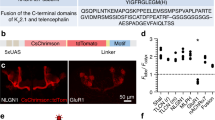Abstract
OLFACTORY transduction is thought to be mediated by a membrane-bound receptor protein initiating a multistep reaction cascade which ultimately leads to a depolarizing generator current1,2. There is considerable evidence for the involvement of adenylate cyclase in vertebrate olfactory transduction3–6, and some data indicate that phospholipase C may have a central role in insect olfaction7. However, one must show that odorants not only stimulate enzyme activity but also induce changes in concentrations of relevant second messengers. One important criterion for a candidate second messenger of chemo-electrical transduction is that its formation must precede the onset of the odorant-induced membrane permeability changes which proceed on a subsecond time-scale8. Here we report an odorant-induced, transient accumulation of cyclic AMP in isolated olfactory cilia from rats, and the generation of inositol trisphosphate in antennal preparations from insects, both of which show subsecond time courses that are sufficiently rapid to mediate the odorant-regulated permeability of olfactory receptor cells.
This is a preview of subscription content, access via your institution
Access options
Subscribe to this journal
Receive 51 print issues and online access
$199.00 per year
only $3.90 per issue
Buy this article
- Purchase on Springer Link
- Instant access to full article PDF
Prices may be subject to local taxes which are calculated during checkout
Similar content being viewed by others
References
Lancet, D. A. Rev. Neurosci. 9, 329–355 (1986).
Snyder, S. H., Sklar, P. B. & Pevsner, J. J. biol. Chem. 263, 13971–13974 (1988).
Pace, U., Hansky, E., Salomon, Y. & Lancet, D. Nature 316, 255–258 (1985).
Sklar, P. B., Anholt, R. H. & Snyder, S. H. J. biol. Chem. 261, 15538–15543 (1986).
Nakamura, T. & Gold, G. H. Nature 325, 442–444 (1987).
Lowe, G., Nakamura, T. & Gold, G. H. Proc. natn. Acad. Sci. U.S.A. 86, 5641–5645 (1989).
Boekhoff, I., Strotmann, J., Raming, K., Tareilus, E. & Breer, H. Cell. Signal. 2, 49–56 (1990).
Firestein, S. & Werblin, F. Science 244, 79–82 (1989).
Sass, H., J. comp. Physiol. 152, 309–317 (1983).
Eckstein, P. D., Cassel, D., Levkovitz, H., Lowe, M. & Selinger, Z. J. biol. Chem. 254, 9829–9836 (1979).
Jones, D. T. & Reed, R. Science 244, 790–795 (1989).
Kaissling, K. E. A. Rev. Neurosci. 9, 121–145 (1986).
Blazynski, C. & Cohen, A. I. J. biol. Chem. 261, 14142–14147 (1986).
Cote, R. H., Nicol, S. A., Burke, S. A. & Bownds, M. D. J. biol. Chem. 261, 12965–12975 (1986).
Fesenko, E. E., Kolesnikow, S. S. & Lubarsky, A. L. Nature 313, 310–313 (1985).
Anholt, R. H., Aebi, U. & Snyder, S. H. J. Neurosci. 6, 1962–1969 (1987).
Steiner, A. L., Pagliara, A. S., Chase, L. R. & Kipnis, D. M. J. biol. Chem. 247, 1114–1120 (1972).
Palmer, S., Hughes, K. T., Lee, D. Y. & Wakelam, M. J. O. Cell. Signal. 1, 147–156 (1989).
Bradford, M. M. Analyt. Biochem. 65, 248–254 (1976).
Barman, T. E. & Gutfreund, H. in Rapid Mixing and Sampling Techniques in Biochemistry (eds Chance, B., Eisenhardt, R. H., Gibson, Q. H. & Lonberg-Holm, K. K.) 339–344 (Academic, New York, 1964).
Author information
Authors and Affiliations
Rights and permissions
About this article
Cite this article
Breer, H., Boekhoff, I. & Tareilus, E. Rapid kinetics of second messenger formation in olfactory transduction. Nature 345, 65–68 (1990). https://doi.org/10.1038/345065a0
Received:
Accepted:
Issue Date:
DOI: https://doi.org/10.1038/345065a0
This article is cited by
-
The role of the odorant receptors in the formation of the sensory map
BMC Biology (2021)
-
Topographic organization in the olfactory bulb
Cell and Tissue Research (2021)
-
Comparative proteomic analysis of olfactory rosettes in anadromous Coilia nasus and resident Coilia nasus
Journal of Oceanology and Limnology (2019)
-
The role of the coreceptor Orco in insect olfactory transduction
Journal of Comparative Physiology A (2013)
-
Calcium-stores mediate adaptation in axon terminals of Olfactory Receptor Neurons in Drosophila
BMC Neuroscience (2011)
Comments
By submitting a comment you agree to abide by our Terms and Community Guidelines. If you find something abusive or that does not comply with our terms or guidelines please flag it as inappropriate.



